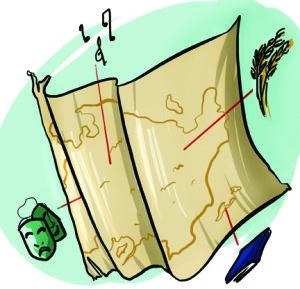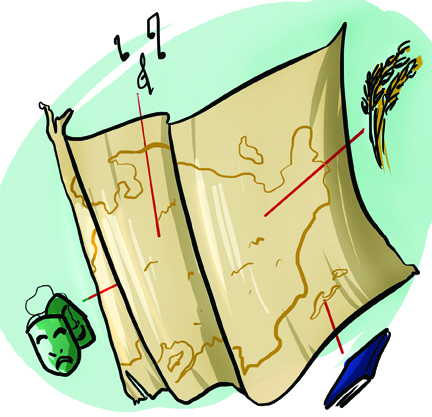
The Spatial History Lab, located on the top floor of Wallenberg Hall, resembles the office of a thriving new start-up. The brightly lit space is filled with computers and whiteboards, the walls are lined with maps and infographics, and a water cooler sits somewhere in the corner.
Studying history, it seems, is no longer a matter of poring over books in a library, but a matter of exploring the past and present dynamically.
“The idea behind it is that history takes place in space, as well as time, so historians study change over time, but the changes that take place across space are just as important,” said History Prof. Jon Christensen ’81 M.A. ’06 Ph.D. ’12, a principal investigator of multiple projects in the lab.
Christensen, along with fellow history professors Richard White and Zephyr Frank, founded the lab in 2007 with a grant given to White by the Mellon Foundation. Since its inception, the lab has branched out into several research project topics spanning from ecological history in the Bay Area to Chinese-Canadian immigration.
The spatial aspect of the research, however, has remained consistent. The group’s output includes research papers as well as animated displays of data and trends throughout time and space, which are posted on the group’s website.
According to Frank, the lab’s current director, creating a dynamic visualization of a historical event allows a researcher to glean new perspectives.
“Visualization leads us to be explicit about spatial dimensions in historical arguments, instead of assuming space is an empty container and human activity is autonomous to spatial constraints,” he said.
For instance, a group of researchers developed a visualization of a yellow fever outbreak in Rio de Janeiro in 1850. The visual overlays a map of the region with discrete points showing individual incidences of yellow fever and continuous colored regions indicating hot spots of the epidemic. The display is then animated through the months that the epidemic occurred, allowing a viewer to see how the disease moved across the city through space and time.
“[Conventional] literature tends to refer to epidemics as a unified whole,” Frank said. “An epidemic is usually referred to very generally by city and by year.”
This approach overlooks the individual experience or, as Frank termed it, “what one person in Rio is thinking about right now, yesterday or last week.”
The visualization revealed the surprising trend that the disease migrated unpredictably instead of spreading outward from a point of origin, appearing in different locations in a seemingly random fashion.
According to Frank, the visualization thus allows a modern observer to experience the human side of the event — the increased sense of fear brought on by the idea that the disease spread to new places randomly and without warning.
To affiliated researchers, the visual aspect of the lab allows for new trends and insights to be extracted from old information.
“Mapping data spatially enables us to tease apart relationships that would not otherwise be apparent were the data stuck in spreadsheet form,” said Jenny Rempel ’12 in an email to The Daily.
Rempel, an earth systems major and Daily columnist, has been working with Christensen to study the interactions between natural and urban areas in cities. She said that the spatial tools she has used have been crucial to understanding these correlations.
“Spatial analysis lets us visualize otherwise static and cumbersome data in a more dynamic and understandable fashion, and, in the process, it makes this data accessible to a much wider audience,” Rempel said.
Along with representing data visually, the lab is also concerned with extracting existing data. Often information exists in forms that are dense in data but difficult to understand easily — for example, as points on a map or scattered references in an historical text.
Cameron Blevins, a third-year graduate student specializing in American history, is working on a study of 19th-century Texas newspapers to reconstruct how the period’s newspapers presented geographic conceptions of the world to their readers. His research involves mining unstructured texts to extract place names.
“In an age of ‘big data,’ scholars from history to literature are facing a deluge of information and sources to analyze,” Blevins said in an email to The Daily. “The problem is not necessarily going to be a problem of scarcity, but one of abundance.”
In this respect, the Spatial History Lab is as much a technological study as it is an historical one. To compile and parse historical data, the lab uses a program that can pick up cues such as geographical references in historical literature so that they can be recognized by a computer. To this end, the lab enlists people from a variety of disciplines.
While the areas of study may interest students majoring in history or urban studies, the data-processing angle has attracted engineering and computer science students, as well.
“This project has opened their minds to creative possibilities in the humanities,” Christensen said. “If human beings are an important part of the human-computer interaction, one must understand the human side of the equation, and that’s what the humanities are about.”
The interdisciplinary nature of the lab is one reason why it has grown to become a highly collaborative research facility.
“The degree of complexity and the technical knowledge that’s required in a project generally exceeds any one person’s capacity,” Frank said.
The collaborative atmosphere is highly appealing to student researchers such as Blevins.
“It offers a think-tank workspace in which people can bounce ideas off of one another, draw on each other for expertise and be exposed to other projects and topics,” Frank said.
Frank said he envisions increased collaboration with other departments as the project expands. This year, the project began making formal connections with other digital humanities projects such as the Stanford Literary Lab. In fact, a name change for the lab is pending because these two ventures are planning to merge together.
As the lab expands, it continues to attract a wide variety of faculty members and student research assistants.
“[The lab was] one of the main reasons why I applied to Stanford as it was a truly unique resource that no other program in the country could match,” Blevins said.
For its founding members, the continued appeal of the lab’s innovative approach has not gone unnoticed.
“It’s fun and interesting and creative,” Christensen said of the lab. “It’s exciting to work in new ways using computer technologies and techniques to do new kinds of research.”
